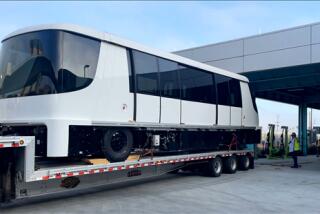Gas-powered carriage didn’t have much speed to burn
- Share via
The Associated Press reported that an alliance of automakers, utilities and clean-air advocates hope to make California a “national leader” in the electric-car industry.
Who knows? California may one day be overrun by Chevy Volts, Nissan Leafs (Leaves?) and Daimler Smart EDs (“ED” in this case means “electric drive”).
FOR THE RECORD:
Then and Now: In the Dec. 19 California section, the Then and Now column and an accompanying photo caption identified a passenger in an 1897 motorized coach ride through downtown Los Angeles as Boyle Workman. The passenger was William H. Workman, Boyle Workman’s father. —
More than a century ago, however, Los Angeles had less than good fortune with its own homegrown car brand: the Erie and Sturgis Gasoline Carriage.
Created by engineer J. Philip Erie and machine shop owner S.D. Sturgis, it was the first gasoline-powered vehicle to take to the streets of Los Angeles.
But you had to get up early to see it.
The Erie-Sturgis made its debut at 2 a.m. on May 30, 1897, an hour when the streets would be deserted “except for a few sleepy policemen and wildly careering milkmen,” The Times said.
The automakers wanted to avoid horses, which might be scared “because of the noise of the gasoline motors and the gasoline explosions.”
For Erie, it was the culmination of a dream he’d had for two years after heading west with the idea for a “motor carriage.”
He took out 30 patents and raised $30,000 for the prototype.
“The innocent-looking black tally-ho has about 25 miles an hour concealed in its vitals,” The Times said admiringly.
Though German engineer Karl Benz had been granted a patent for a gasoline-powered auto in 1886, the concept was still novel to the dusty little pueblo of Los Angeles.
A Times caption writer labeled a drawing of it “The New Motor-Cycle.”
Erie, Sturgis, their wives and a few other acquaintances gathered in the early morning hours to make the test run.
The vehicle was rolled out of Sturgis’ shop on West 5th Street, then pushed down a long alley out onto Broadway.
“The gasoline engine was set to working [and] with a twist of the lever” by Erie, the driver, the intrepid group set off southward on Broadway. (They were on their own in case trouble struck; the Auto Club wouldn’t be founded until 1900.)
The carriage turned left on 6th Street and handled the “awful 6th Street pavement so smoothly that the passengers scarcely felt any motion at all,” The Times marveled.
Erie turned right on Main Street, “crossing car tracks and chuckholes innumerable without any trouble,” and turned on 7th Street. From there the passengers rumbled about a mile eastward to Erie’s house near Hollenbeck Park, “stopping occasionally for repairs.”
They passed several horses who displayed “not the slightest fear of the novel spectacle.”
The test run, The Times said, was “a gratifying success in every way.” And the newspaper assured readers “that in all probability it will not be long before a factory is established in Los Angeles for the manufacture of motor wagons.”
But a rival paper, the Sunday Herald, disagreed, asserting that the carriage — operating on just one of its four cylinders — “barely moved” faster than pedestrian traffic and didn’t come close to doing 25 mph.
At least the tally-ho didn’t break the law — the speed limit in those days was 8 mph for bicycles.
It did have a problem, however: overheating.
A few days after the test run, The Times blamed the snafu on a parts supplier.
The asbestos that was wrapped around the engine “burned like brown paper,” the newspaper said, and was a “sham.”
But even with real asbestos and “a fancy cooling device to spray water through the engine compartment air,” a historian told The Times in 1973, “the builders were unable to control the fiery emissions from their motor wagon.”
Erie took the contraption out on a few other “short trial runs,” including one with Boyle Workman, a banker from one of Los Angeles’ pioneer families.
Perhaps the ride with Workman didn’t go smoothly. Erie, running low on cash and backers, couldn’t conquer the heat problem.
He finally abandoned the operation before the year was out and reportedly went into mining.
The car never ran again and its fate was not recorded. Could it have been sent to L.A.’s first auto wrecking yard?






